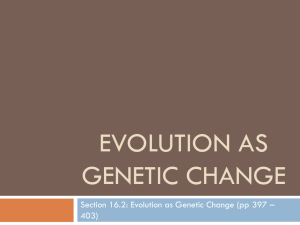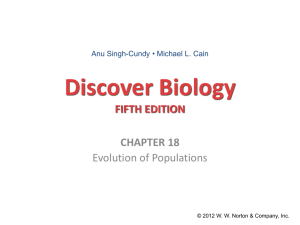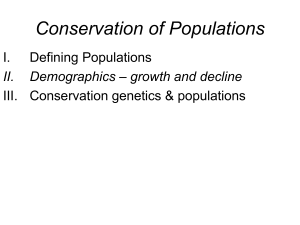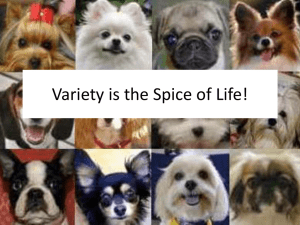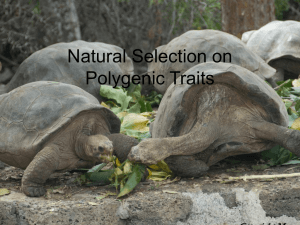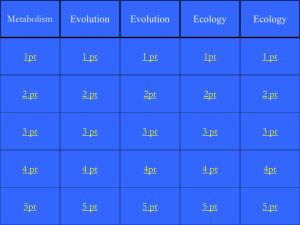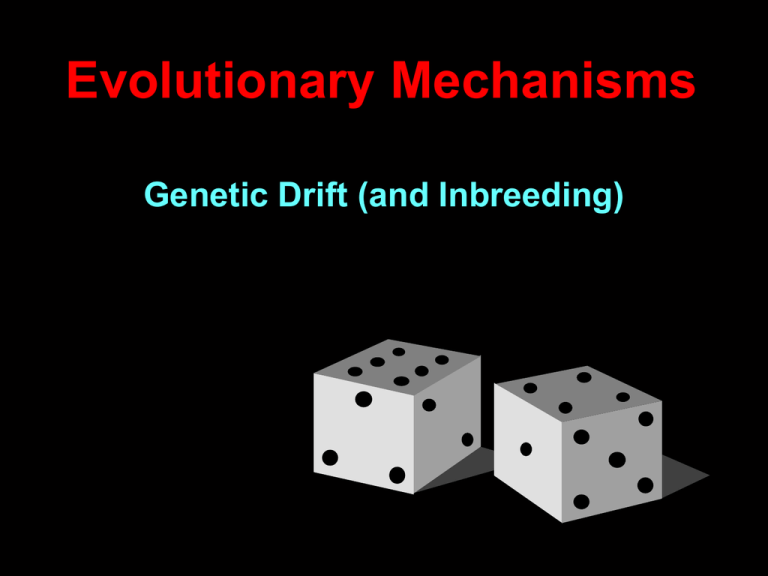
Evolutionary Mechanisms
Genetic Drift (and Inbreeding)
DEVIATION
from
Hardy-Weinberg Equilibrium
Indicates that
EVOLUTION
Is happening
4 Major Evolutionary Mechanisms that
alter allele frequencies in populations:
Genetic Drift
Natural Selection
Mutation
Migration
1 Evolutionary Mechanism that alters
heritable expression of those alleles:
Epigenetic Inheritance
Sources of Genetic Variation
Mutation generates
genetic variation
Natural Selection
Natural Selection acts on
genetic or epigenetic
variation in a population
Without genetic or
epigenetic variation,
Natural Selection cannot
occur
Epigenetic modification
changes expression of
genes
Genetic Drift causes
fluctuations in allele
frequencies and can
reduce genetic variation
Sources of Genetic Variation
Mutation generates
genetic variation
Natural Selection
Natural Selection acts on
genetic or epigenetic
variation in a population
Without genetic or
epigenetic variation,
Natural Selection cannot
occur
Epigenetic modification
changes expression of
genes
Genetic Drift causes
fluctuations in allele
frequencies and can
reduce genetic variation
Today’s OUTLINE:
(1) Migration
(2) Genetic Drift
(3) Effective Population Size
(4) Model of Genetic Drift
(5) Heterozygosity
(6) A Consequence of Genetic Drift: Inbreeding
Migration (fairly obvious)
Can act as a Homogenizing force
(If two populations are different, migration between
them can reduce the differences)
A population could go out of HW equilibrium
with a lot of migration
Impact of Migration
Immigration: could introduce
genetic variation into a population
Emigration: could reduce genetic
variation in a population
Random Genetic Drift
Sewall Wright (1889-1988)
• Sewall Wright worked on agricultural
stocks (e.g. cows), and was
consequently interested in small,
inbred populations
• Thus, he regarded Inbreeding and
Genetic Drift as particularly
important genetic mechanisms
• Genetic Drift and Inbreeding could
generate new gene interactions
• These new gene interactions
(epistasis caused by new
recombinations) are the main
substrate for selection
“Null Model”
No Evolution: Null Model to test if no evolution
is happening should simply be a population in
Hardy-Weinberg Equilibrium
No Selection: Null Model to test whether
Natural Selection is occurring should have no
selection, but should include Genetic Drift
This
is because Genetic Drift is operating even
when there is no Natural Selection
“Null Model”
No Selection: A model that tests for the
presence of Natural Selection should include
Genetic Drift
This
is because Genetic Drift is operating even
when there is no Natural Selection
So
the null model that tests for natural selection
should include demography, population growth
and decline, as population size directly affects the
level of genetic drift acting on a population
Even after the synthesis the relative importance of
Natural Selection and Genetic Drift were debated
• During the Evolutionary Synthesis, Sewall Wright focused
more on importance of Genetic Drift, whereas Fisher focused
on Natural Selection
• Shortly after the Evolutionary Synthesis many focused on
selection to the point of assuming that most phenotypes were
the result of Natural Selection
• Emphasis on Genetic Drift resurged in the 1970s, 80s with
Kimura’s “Neutral Theory”
• Then in the 2000s and 2010s interest in Selection increased
with the ability to detect signatures of Natural Selection in
genome sequence data
Motoo Kimura (1924-1994)
The Neutral Theory of
Molecular Evolution
Classic Paper: Kimura, Motoo. 1968.
Evolutionary rate at the molecular level.
Nature. 217: 624–626.
Classic Book: Kimura, Motoo (1983). The
neutral theory of molecular evolution.
Cambridge University Press.
Molecular Clock
Observations of amino acid changes that occurred during the divergence
between species, show that molecular evolution (mutations) takes place at
a roughly constant rate.
This suggests that molecular evolution is constant enough to provide a
“molecular clock” of evolution, and that the amount of molecular change
between two species measures how long ago they shared a common
ancestor.
From this, Kimura concluded that not
much selection is going on (because
the pattern of regular mutations is not
obscured by selection), and that most
evolution is influenced by Genetic Drift.
Figure: the rate of evolution of hemoglobin.
Each point on the graph is for a pair of
species, or groups of species. From Kimura
(1983).
The Neutral Theory of
Molecular Evolution
• The Neutral theory posits that the vast majority
of evolutionary change at the molecular level is
caused by random genetic drift rather than
natural selection.
Motoo Kimura
• Neutral theory is not incompatible with Darwin's theory of
evolution by natural selection: adaptive changes are
acknowledged as present and important, but hypothesized to be a
small minority of evolutionary change.
• Recent tests of selection have found that in many cases evolution
is not neutral, even in non-coding regions of the genome.
• Nevertheless, the neutral theory is useful as the null hypothesis,
for testing whether natural selection is occurring.
I. Random Genetic Drift
Definition: Changes in allele frequency from
one generation to the next simply due to chance
(sampling error).
This is a NON ADAPTATIVE evolutionary
force.
Darwin did not consider genetic drift as an
evolutionary force, only natural selection.
Genetic Drift
Genetic Drift happens when populations are
limited in size, violating HW assumption of
infinite population size
When population is large, chance events cancel
each other out
When population is small, random differences in
reproductive success begin to matter much more
Effective Population Size
In Evolution, when we talk about
population size, we mean
effective population size
Effective Population Size
The concept of effective population size
Ne was introduced by Sewall Wright, who
wrote two landmark papers on it (Wright
1931, 1938).
Sewall Wright defined it as "the number of breeding
individuals in an idealized population that would show the
same amount of dispersion of allele frequencies under
random genetic drift or the same amount of inbreeding as the
population under consideration”
OK, easier definition: Effective population size is the
number of individuals in a population that actually
contribute offspring to the next generation.
Effective Population Size
The effective population size is usually smaller than the real
census population size because not everyone breeds and
leaves offspring The effective population size is always either
equal to or less than the census population size (N).
Unequal sex ratio, variation in number of offspring,
overlapping generations, fluctuations in population size,
nonrandom mating could lead to an effective population size
that is smaller than the census size.
Ne =
4Nm Nf
(Nm + Nf )
where Nm = number of males, Nf = number of females
from this equation, you can see that unequal sex ratio would lead
to lower Ne
Why do we care about effective population
size Ne?
Because Ne is the actual unit of evolution,
rather than the census size N
Why? Because only the alleles that actually
get passed onto the next generation count in
terms of evolution… the individuals that do
not mate or have offspring are evolutionary
dead ends…
Chance Events (no Selection)
There is always an element of chance, in:
Who leaves Offspring
# of Offspring
Which Offspring survive
(which gametes, which alleles)
Example of sampling error
Green fur:
Blue fur:
G (dominant)
b (recessive)
If Gb x Gb mate, the next generation is expected to have: 3:1
Ratio of Green to blue (GG, Gb, bG, bb)
But this might not happen
One family could get this unusual frequency just due to chance:
You might get: bb, bb, bb, bb
And, so you might accidentally lose the G allele not for any
reason, but just due to chance
The larger the population, the more these effects average out,
and frequencies approach HW equilibrium
Why is this not Selection?
Selection happens when some survive for
a reason: better adapted.
Genetic Drift is just a numbers game.
Which gamete gets fertilized, which allele
gets passed on is RANDOM
Consequences of Genetic Drift
Random fluctuations in allele frequency
If population size is reduced:
1. At the Allelic level: Random fixation of Alleles
(loss of alleles)
2. At the Genotypic level: Loss of Heterozygosity
(because of fewer alleles)
Random Shift in Allele Frequencies across Generations
Probability of loss of alleles is greater in
smaller populations
For example, if there are 50 different alleles
in population
…and a new population is founded by only
10 individuals
Then the new population will be unable to
capture all 50 alleles, and many of the alleles
will be lost
Bottleneck Effect
Random fixation of alleles
FIXATION: When an allele frequency becomes 100%
The other alleles are lost by chance
Fluctuations are much larger in smaller populations
Probability of fixation
of an allele
Probability of fixation of an allele =
the allele’s starting frequency
(Sewall Wright 1931)
That is, if the frequency of an allele
is 0.10 (10% in the population),
then its probability (chances) of
fixation (going to 100% in the
population) is 0.10, or 10%
Probability of fixation
of an allele
Probability of fixation of an allele =
the allele’s starting frequency
(Sewall Wright 1931)
That is, if the frequency of an allele
is 0.10 (10% in the population),
then its probability (chances) of
fixation (going to 100% in the
population) is 10%
WHY?
Probability of fixation
of an allele
If a population has 2N alleles
The probability of each allele being
fixed = 1
2N
If there are X # copies of that allele in
the
population, then the probability of
fixation for that allele is X
2N
This is the proportion (%) of alleles in
the population
Genetic Drift: Random Fixation
Genetic Drift: Random Fixation
After 7
generations, all
allelic diversity
was lost… the
population
became fixed for
allele #1 just due
to chance
Genetic Drift:
Random Fixation
As populations get
smaller, the probability
of fixation goes up
Heterozygosity
Heterozygosity: frequency of heterozygotes in
a population = 2p(1-p)
As genetic drift drives alleles toward fixation or
loss, the reduction in number of alleles causes
the frequency of heterozygotes to go down
Heterozygosity
Heterozygosity: frequency of heterozygotes in
a population
Often used as an estimate of genetic variation
in a population
The expected heterozygosity following a
population bottleneck (frequency of
Heterozygotes in the next generation = Hg+1):
g+1
g
Note in this equation that as
population size 2N gets small,
heterozygosity in the next
generation Hg+1, goes down
Loss of Variation
Allele frequencies
0.36
Lots of Alleles:
0.16
0.20
0.24
0.04
Lots of alleles --> Lots of genotypes:
Possible genotype combinations
Loss of Allelic Variation
Allele frequencies
Due to Genetic Drift
0.53
0.067
0.20
0.20
0
Loss of Allelic Variation due to
Genetic Drift results in
Increased Homozygosity
Fewer possible genotype combinations
Increase in homozygosity
No Genetic Variation = No Natural
Selection
No Genetic Variation = No Natural
Selection
Selection has nothing to act on
Genetic Drift and Natural Selection
Because of the randomness introduced by
Genetic Drift, Natural Selection is less
efficient when there is genetic drift
Thus, Natural Selection is more efficient in
larger populations, and less effective in
smaller populations
Allele A1 Demo
• Impact of Effective Population Size
• Impact of starting allele frequency
• Interaction between Natural Selection
and Genetic Drift
How do you detect Genetic Drift?
Random fluctuations in allele frequencies
Fluctuations in non-coding and non-functional
regions of the genome
The same pattern of fluctuations across these
regions of the genome (same demographic factors
would act across the genome)
Fluctuations in allele frequencies correspond to
demography of the population (population size)
Consequences of Genetic Drift
---> Random fluctutations in allele frequency
If population size is reduced and Drift acts more
intensely, we get:
1. At the Allelic level: Random fixation of Alleles
(loss of alleles)
2. At the Genotypic level: Inbreeding, Reduction
in Heterozygosity (because of fewer alleles)
Dilemma for Conservationists
• It is easier to remove genetic diversity
than create it… especially variation that
is potentially adaptive
Census size: Roughly
2000-3000 cheetahs
live in Namibia today
The effective
population size is
much lower
2. Genetic Drift often
leads to Inbreeding
Inbreeding is a consequence of Genetic drift
in small populations, resulting from loss of
alleles
Due to loss of alleles, there is an increase in
homozygosity
With small population size,
heterozygosity goes down,
homozygosity goes up
Inbreeding
Mating among genetic relatives, often
because of small population size
Alleles at a locus will more likely become
homozygous
A consequence of loss of alleles due to genetic
drift (reduction in population size)
Calculations like these are used in genetic counseling
and animal breeding to calculate F, the coefficient of
inbreeding (developed by Sewall Wright)
Show popgen pedigree
F = fixation index, a measure of homozygosity
The inbreeding coefficient is the
measure of relatedness between two
individuals… used a lot in agriculture,
genetic counseling, etc.
small population size genetic drift
loss of alleles decrease in
heterozygosity increase in
homozygosity
increase of exposure of deleterious
alleles
Consequences of Inbreeding
Increase in Homozygosity:
Exposure of recessive alleles
(that could be subjected to selection)
Inbreeding Depression
(reduction in survival and fitness)
Lower genotypic diversity (poor response to
natural selection)
Consequences of Inbreeding
• Deleterious recessive alleles are exposed as
homozygotes
(and less masked in the heterozygous state)
• These deleterious recessive alleles get removed out of
an inbred population more rapidly, because they are
exposed to natural selection
---> this process is aided by Sex, discussed in Next
Lecture (on Variation)
Mechanism:
Most deleterious alleles are
recessive
Alleles
On average each of us carries 35 lethal recessive alleles
Locus1
A
a
These deleterious alleles are
expressed in inbred individuals
Locus2
B
b
Locus3
C
c
In Heterozygotes, these
deleterious recessives are
masked, and not exposed to
selection
Increasing genetic distance
Fitness
Inbreeding
Depression
Hybrid Vigor
Outbreeding
Depression
Examples of Inbreeding
Inbreeding and Conservation
Vexing Problem:
How do we prevent extinctions?
How do we maximize genetic variance in a population?
What should we preserve?
(species, populations, habitats, ecosystems???)
Inbreeding and Agriculture:
Because we have focused excessively on a few
breeds, effective population sizes of many crops
are incredibly small
600 breeds of livestock have disappeared
~78 breeds lost each year
1000-1500 breeds of livestock are
considered at risk of extinction
(30% of current breeds)
8 million Holstein cows are
descendents of 37 individuals!!!
Neurological disorders
Autoimmune diseases
Fertility problems
Recent efforts have focused on outcrossing to
increase fitness in agricultural stocks
Duvick, D. N. 2002. Biotechnology in the 1930s: the development of hybrid maize.
Nature Reviews Genetics. 2: 69-74.
Bruce, W. B., G. O. Edmeades, and T. C. Barkre. 2002. Review Article: Molecular
and physiological approaches to maize improvement for drought tolerance. Journal
of Experimental Botany. 53: 13-25.
Inbreeding
depression in
humans
Genetic Diseases due to Inbreeding have
afflicted many Royal Families
George III
Insane due to
Porphyria
Examples:
Porphyria: accumulation of porphyrin
precursors, causes insanity;
Dominant, but more intense in the
homozygous form
Mary, Queen of Scots
George III, loss of American colony
Acromegaly: Overproduction of GH
by the pituitary gland; recessive
Charles II, King of Spain (1665-1700)
Hemophilia: “Victoria’s Secret”
Charles II
“Hapsburg Jaw”
X-linked, shows up in males
Cognitively disabled
Daughters spread it among the royals,
impotent
downfall of Russian monarchy
Porphyria in the Royal Families of Europe
George III
Dominant, but more intense in the homozygous form
Royal Pedigree of the
“Hapsburg Jaw”
In small populations,
individuals tend to mate
with relatives
= expression of the disorder
Royal Pedigree of
Hapsburg Jaw
= expression of the disorder
= marriage with close relative
Inbreeding within the Royal
Families of Europe was
genetically “disasterous”
Inbreeding within Royal
Families has been reduced
in recent years
Diana was a 7th cousin of Charles,
rather than a first or second
cousin (which was the normal
practice previously)
Kate Middleton is neither an aristocrat nor
a royal, but the marriage was approved
given the modern recognition of the perils
of inbreeding… this marriage is an
example of genetic immigration (Migration)
into an enclosed population
Articles on British Royalty and Inbreeding:
News Article:
http://www.telegraph.co.uk/news/worldnews/e
urope/spain/5158513/Inbreeding-causeddemise-of-the-Spanish-Habsburg-dynastynew-study-reveals.html
Original Scientific Article:
http://www.plosone.org/article/info:doi/10.1371/jou
rnal.pone.0005174
Amish in Lancaster County, PA
Descendents of ~200 Swiss who emigrated mid-1700s.
Closed genetic
population for 12+
generations.
Host to 50+ identified
inherited disorders
(many more
uncharacterized)
Examples of Diseases that Afflict Amish Populations
High levels of infant mortality
High Incidence of brain damage
Large number of metabolic disorders, such as PKU
Ellis-van Creveld (dwarfism) syndrome
1/14 in Amish
Glutaric aciduria type I
1/200 in Amish
High incidence of bipolar
disorder
Polydactyly (6 fingers)
There is nothing special about the Amish,
genetically speaking (or Royal Families).
• There are about ~200 of you here, similar to the size of the
founding Amish population in Lancaster county, Pennsylvania.
• If all of you were stranded on a desert island, eventually your
descendents would be related and mating with one another.
• Each of us carries 3-5 lethal recessive alleles.
• If 200 people each had 3-5 different recessive lethals and
started forming a closed population, eventually, hundreds of
genetic disorders would emerge.
Dating Service
FIND Your Genetically
Most Distant Mate!!!!
(For example, Scientificmatch.com
matches people that differ in their
MHC loci; people that differ at these
loci tend to be more attracted to one
another)
Summary
(1) Genetic Drift occurs when a population is small,
and leads to random loss of alleles due to
sampling error
(2) Inbreeding, an extreme consequence of Genetic
Drift, results in increases in homozygosity at many
loci, including recessive lethals
CONCEPTS
Genetic Drift
Effective population size
Fixation
Heterozygosity
Inbreeding
Inbreeding Depression
Heterozygote advantage
1. When is Genetic Drift LEAST likely to operate?
(A) When there are migrants between populations
(B) When populations are fragmented and isolated
(C) When population size is small
(D) When population size is very very large
2. Which of the following is FALSE regarding
inbreeding?
(A) Inbreeding could result as a consequence after
genetic drift has acted on a population
(B) Populations with lower allelic diversity tend to have
lower genotypic diversity (more homozygous)
(C) Selection acts more slowly in inbred populations to
remove deleterious recessive alleles
(D) One way to reduce inbreeding in a population is to
bring in migrants from another population
3. Which of the following is FALSE regarding
Genetic Drift?
(A) Genetic Drift occurs more rapidly in
smaller populations
(B) In populations of finite size, random
changes in allele frequency occur at each
generation
(C) Genetic Drift could lead to inbreeding due
to loss of alleles
(D) Genetic Drift occasionally leads to the
generation of favorable alleles
Answers to sample exam
questions:
1D
2C
3D

